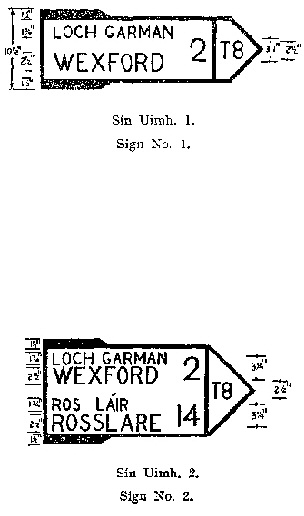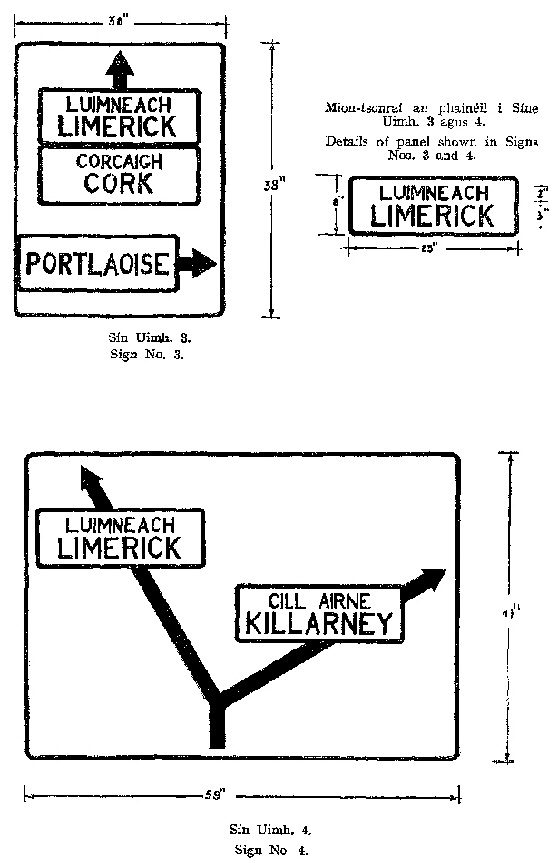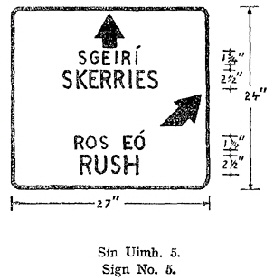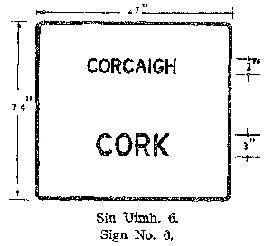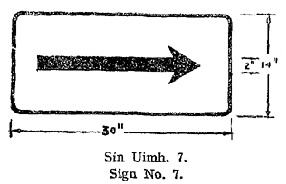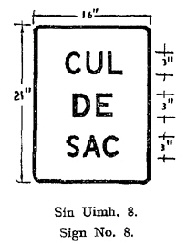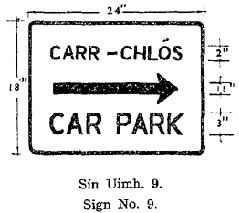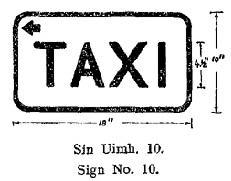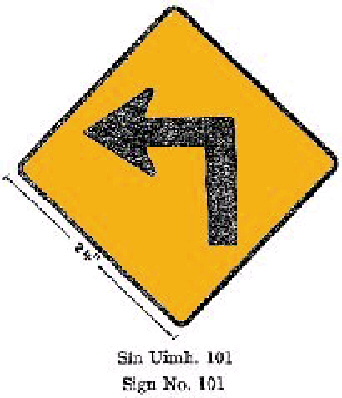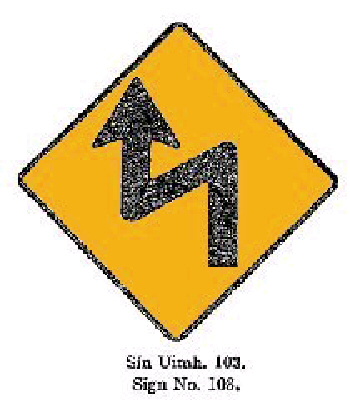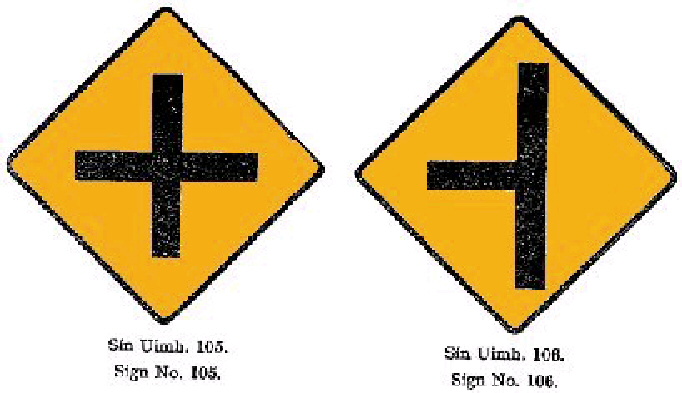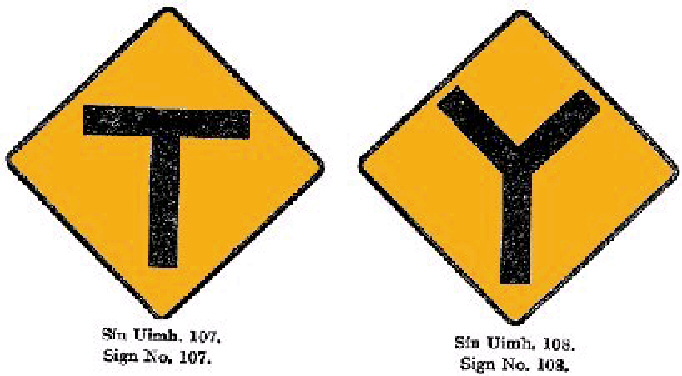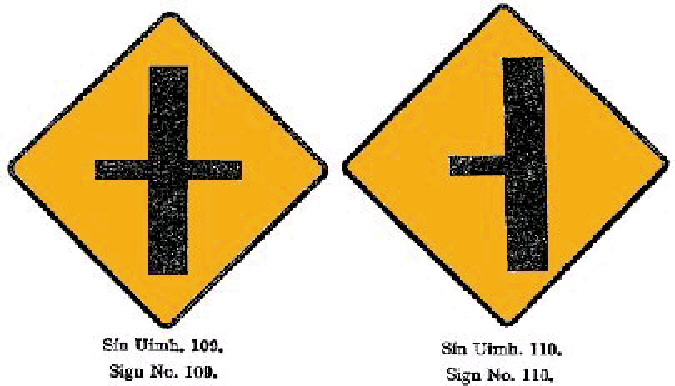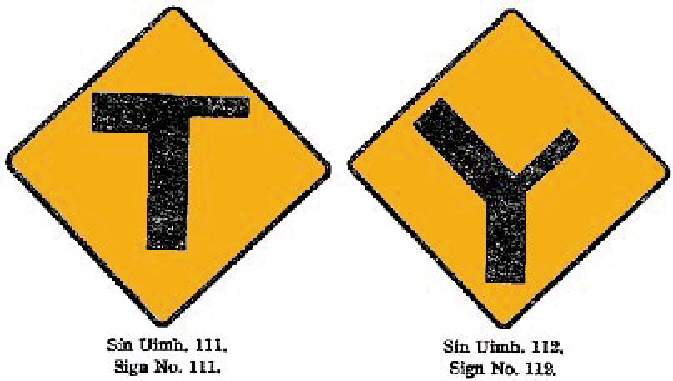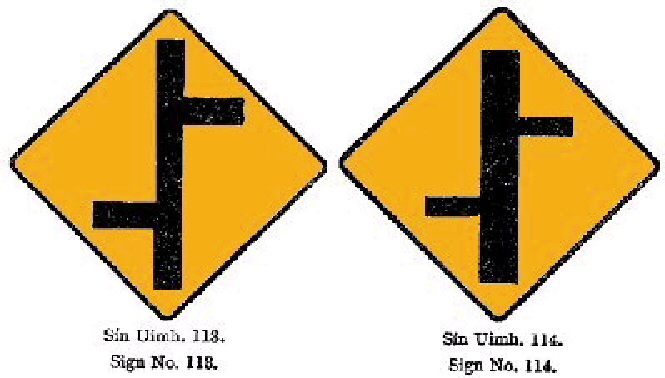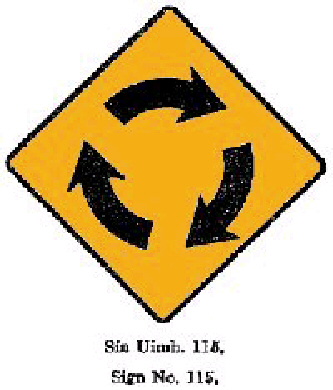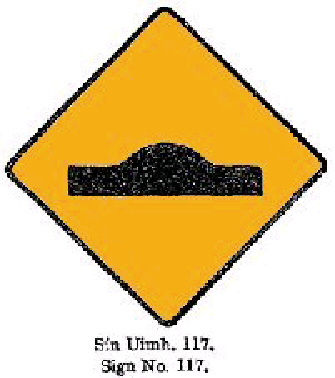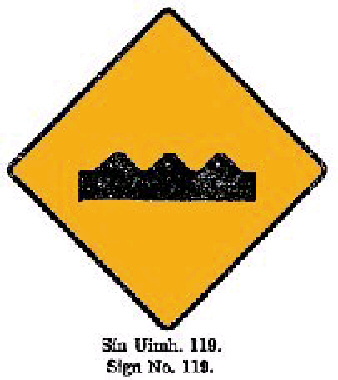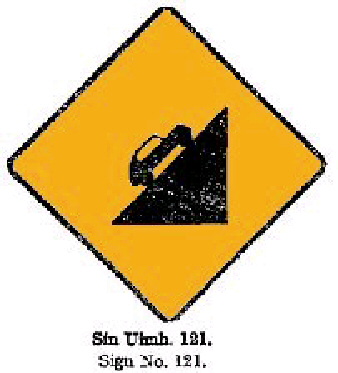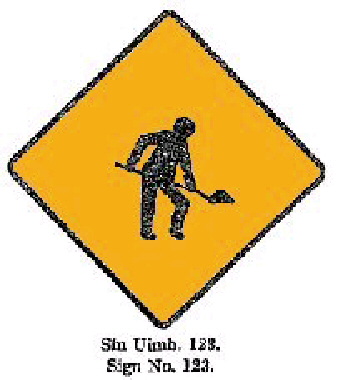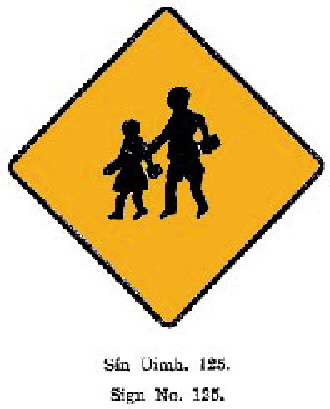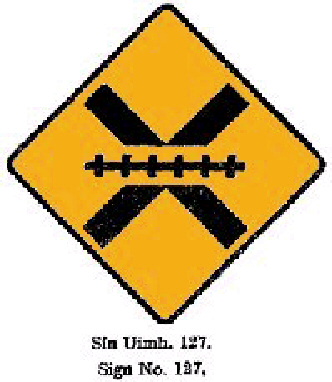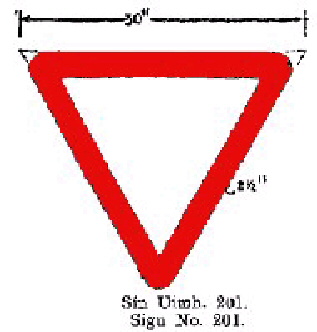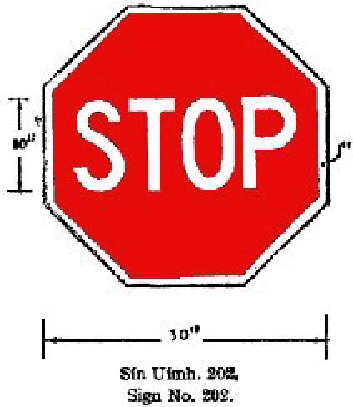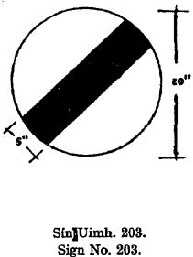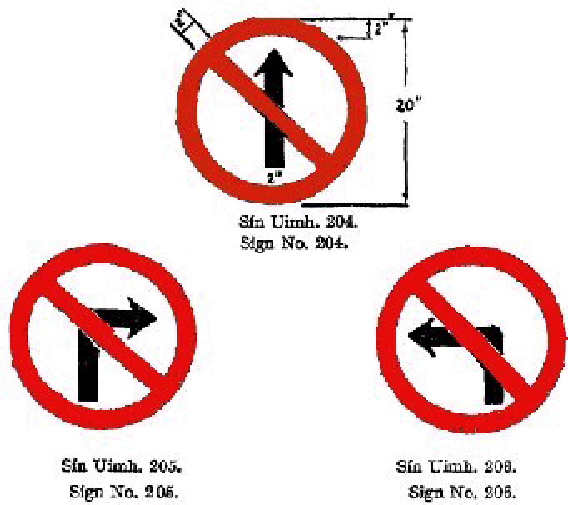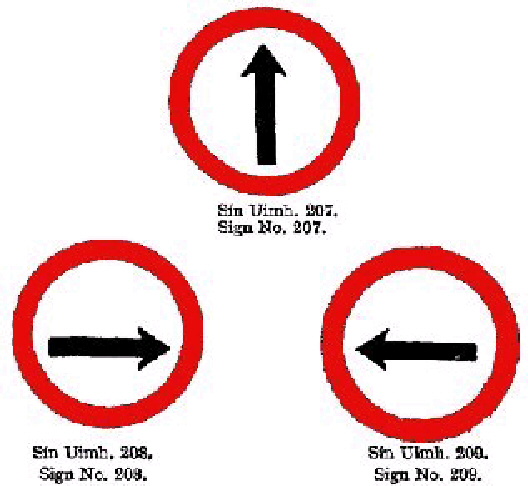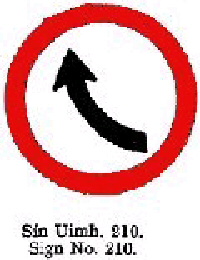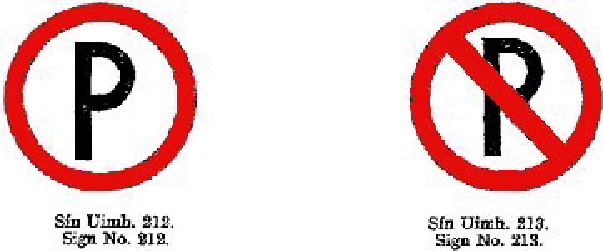S.I. No. 284/1956 -- Traffic Signs Regulations, 1956.
|
S.I. No. 284/1956: TRAFFIC SIGNS REGULATIONS, 1956. |
|||||||||||||||||||||||||
|
TRAFFIC SIGNS REGULATIONS, 1956. |
|||||||||||||||||||||||||
|
The Minister for Local Government, in exercise of the powers vested in him by section 69 of the Local Government Act, 1946 (No. 24 of 1946), as amended by section 36 of the Local Government Act, 1955 (No. 9 of 1955), hereby makes the following Regulations :-- |
|||||||||||||||||||||||||
| Citation | |||||||||||||||||||||||||
|
1. These Regulations may be cited as the Traffic Signs Regulations, 1956. |
|||||||||||||||||||||||||
| Definitions. | |||||||||||||||||||||||||
|
2.--(1) In these Regulations, save where the context requires otherwise, the following expressions shall have the meanings hereby assigned to them :-- |
|||||||||||||||||||||||||
|
" the Minister " means the Minister for Local Government ; |
|||||||||||||||||||||||||
|
" bus-stop " means a stopping place for omnibuses appointed as such under a road regulation, and " bus-stop sign " means a sign to indicate such a stopping place ; |
|||||||||||||||||||||||||
|
" dual carriageway " means a road the roadway of which is divided centrally so as to provide two separate roadways for traffic, each being a one-way roadway ; |
|||||||||||||||||||||||||
|
" left " shall be construed with reference to the direction in which traffic is facing ; |
|||||||||||||||||||||||||
|
" parking " means keeping or leaving a mechanically propelled vehicle (whether in charge or not in charge of any person) stationary ; |
|||||||||||||||||||||||||
|
" pedestrian crossing " means a portion of the roadway specially marked for use by pedestrians crossing the road ; |
|||||||||||||||||||||||||
|
" road " means a public road and includes any section of a public road ; |
|||||||||||||||||||||||||
|
" roadway " means that portion of any road which is provided primarily for the use of vehicles ; |
|||||||||||||||||||||||||
|
" one-way roadway " means a roadway the traffic on which is for the time being required by a road regulation to proceed in one direction only ; |
|||||||||||||||||||||||||
|
" roadway markings " means markings placed on the surface of the roadway ; |
|||||||||||||||||||||||||
|
" roundabout " means a road junction so constructed that traffic which enters it must proceed slowly in a circular direction ; |
|||||||||||||||||||||||||
|
" passenger road service " has the same meaning as in the Road Transport Act, 1932 (No. 2 of 1932) as amended by the Road Transport Act, 1933 (No. 8 of 1933) ; |
|||||||||||||||||||||||||
|
" route letter and number " means the route letter and number assigned to the route comprising such road by the Minister in any classification of roads made by him under subsection (2) of section 17 of the Ministry of Transport Act, 1919 ; |
|||||||||||||||||||||||||
|
" special speed limit " means a speed limit prescribed under section 48 of the Road Traffic Act, 1933 (No. 11 of 1933) ; |
|||||||||||||||||||||||||
|
" staggered road junction " means a sequence of two road junctions in close proximity, the second junction occurring on the opposite side to the first ; |
|||||||||||||||||||||||||
|
" standing for street service vehicles " means a place (appointed as such under a road regulation) at which street service vehicles may stand for hire ; |
|||||||||||||||||||||||||
|
" traffic " includes vehicles and animals of every description but does not include pedestrians, and where " traffic " is referred to as having rights or obligations the word shall connote the persons driving, riding or managing or controlling the vehicles or animals concerned ; |
|||||||||||||||||||||||||
|
" traffic refuge " means a refuge for pedestrians on a roadway provided by a raised pavement, guard posts or similar means ; |
|||||||||||||||||||||||||
|
" vehicle," " mechanically propelled vehicle," " street service vehicle," " taximeter area " and " omnibus " have the meanings assigned to them by the Road Traffic Act, 1933 (No. 11 of 1933) ; |
|||||||||||||||||||||||||
|
" upright sign " means a traffic sign (other than a lamp, roadway or wall marking, or instrument for giving signals by mechanical means) erected on or beside a road, or suspended over a road ; |
|||||||||||||||||||||||||
|
" informative sign " means an upright sign which gives information in regard to a road, including the places to which the road leads and the distances to or from such places ; |
|||||||||||||||||||||||||
|
" warning sign " means an upright sign which warns persons of danger in relation to a road, or advises the precautions to be taken against such danger, or both ; |
|||||||||||||||||||||||||
|
" regulatory sign " means an upright sign which indicates the existence of a road regulation in relation to a road, or implements such a regulation, or both ; |
|||||||||||||||||||||||||
|
" design " when used in relation to an upright sign means the layout of the sign and includes the relative size and position of any symbols, figures, letters or other markings shown thereon. |
|||||||||||||||||||||||||
|
(2) For the purposes of Parts IV and V of these Regulations-- |
|||||||||||||||||||||||||
|
(a) " white " includes stainless steel and polished aluminium ; |
|||||||||||||||||||||||||
|
(b) " black " includes the colour of the surface of the roadway where that colour offers a reasonable contrast to white ; |
|||||||||||||||||||||||||
|
(c) a continuous line, or a segment of a broken line, may be effected by placing studs side by side or end to end. |
|||||||||||||||||||||||||
|
PART I. INFORMATIVE SIGNS. |
|||||||||||||||||||||||||
| Informative Signs. | |||||||||||||||||||||||||
|
3.--(1) An informative sign shall show the information given in black letters, figures and markings on a white background surrounded by a black border. |
|||||||||||||||||||||||||
|
(2) Place-names shall be shown in Roman letters in Irish and in English and where the spelling of a place-name is the same in both languages one inscription only need be shown on the sign. |
|||||||||||||||||||||||||
|
(3) The shapes, dimensions and designs of informative signs, and the significance to be attached thereto, shall be as set out in Parts I, IV and VII of the Schedule hereto. |
|||||||||||||||||||||||||
|
PART II. WARNING SIGNS. |
|||||||||||||||||||||||||
| Warning Signs. | |||||||||||||||||||||||||
|
4.--(1) A warning sign shall consist of a yellow diamond (being a square with one diagonal vertical, the corners being rounded), on which shall be shown in black a symbol to indicate the nature of the hazard to be met, the yellow diamond being surrounded by a black border. |
|||||||||||||||||||||||||
|
(2) The following shall be as set out in Parts II, V and VII of the Schedule hereto :-- |
|||||||||||||||||||||||||
|
(a) the dimensions and designs of warning signs ; |
|||||||||||||||||||||||||
|
(b) the symbols to be used thereon ; |
|||||||||||||||||||||||||
|
(c) the significance to be attached thereto. |
|||||||||||||||||||||||||
|
PART III. REGULATORY SIGNS. |
|||||||||||||||||||||||||
| Major Road Ahead Sign. | |||||||||||||||||||||||||
|
5.--(1) The regulatory sign to indicate that a road ahead is a major road, the traffic on which has the right of way over traffic approaching from the road on which the sign is provided, shall consist of a red inverted equilateral triangle with rounded corners, the space inside the triangle being either hollow or coloured white. |
|||||||||||||||||||||||||
|
(2) The dimensions and design of the sign to which this article applies shall be as set out in section A of Part III and in Part VII of the Schedule hereto. |
|||||||||||||||||||||||||
| Stop Sign. | |||||||||||||||||||||||||
|
6.--(1) The regulatory sign to indicate-- |
|||||||||||||||||||||||||
|
(a) that a road ahead is a major road, the traffic on which has the right of way over traffic approaching from the road on which the sign is provided, and |
|||||||||||||||||||||||||
|
(b) that traffic so approaching the road ahead must halt before entering it, |
|||||||||||||||||||||||||
|
shall consist of a red octagon with a white border and showing the word " Stop " in white letters. |
|||||||||||||||||||||||||
|
(2) The dimensions and design of the sign to which this article applies shall be as set out in section B of Part III and in Part VII of the Schedule hereto. |
|||||||||||||||||||||||||
| End of Speed Limit Sign. | |||||||||||||||||||||||||
|
7.--(1) The regulatory sign to indicate the end of a stretch of road to which a special speed limit applies shall consist of a white circular disc crossed obliquely by a black bar. |
|||||||||||||||||||||||||
|
(2) The dimensions and design of the sign to which this article applies shall be as set out in section C of Part III and in Part VII of the Schedule hereto. |
|||||||||||||||||||||||||
| Other Regulatory Signs. | |||||||||||||||||||||||||
|
8.--(1) A regulatory sign (other than a major road ahead sign, a stop sign and an end of speed limit sign) shall consist of a white circular disc with a red border, appropriate symbols, figures or letters being shown in black on the disc, an oblique red bar being added whenever a prohibition is indicated. |
|||||||||||||||||||||||||
|
(2) The following shall be as set out in section D of Part III and in Parts VI and VII of the Schedule hereto :-- |
|||||||||||||||||||||||||
|
(a) the dimensions and designs of signs to which this article applies ; |
|||||||||||||||||||||||||
|
(b) the symbols, figures and letters to be used on such signs ; |
|||||||||||||||||||||||||
|
(c) the significance to be attached to such signs. |
|||||||||||||||||||||||||
|
PART IV. PEDESTRIAN CROSSINGS. |
|||||||||||||||||||||||||
| Pedestrian Crossing Signs. | |||||||||||||||||||||||||
|
9.--(1) The traffic signs to indicate a pedestrian crossing shall consist of-- |
|||||||||||||||||||||||||
|
(a) roadway markings in accordance with sub-article (2) of this article to indicate the portion of roadway available for use as a pedestrian crossing, and |
|||||||||||||||||||||||||
|
(b) a device (in this article referred to as a " beacon ") to indicate the location of the pedestrian crossing, consisting of a spherical globe which shall-- |
|||||||||||||||||||||||||
|
(i) be coloured yellow, |
|||||||||||||||||||||||||
|
(ii) show a yellow light at night-time, |
|||||||||||||||||||||||||
|
(iii) be approximately one foot in diameter, and |
|||||||||||||||||||||||||
|
(iv) be mounted not less than seven feet and not more than fourteen feet above the surface of the ground in the immediate vicinity. |
|||||||||||||||||||||||||
|
(2) The roadway markings to indicate a pedestrian crossing shall be as follows :-- |
|||||||||||||||||||||||||
|
(a) where there is a traffic refuge at the pedestrian crossing, there shall be a separate set of markings on each side of the traffic refuge, each set consisting of two parallel continuous white lines which shall-- |
|||||||||||||||||||||||||
|
(i) each be approximately six inches wide, |
|||||||||||||||||||||||||
|
(ii) extend across the roadway from its edge to the nearer limit of the traffic refuge, and |
|||||||||||||||||||||||||
|
(iii) be not less than six feet and not more than twenty feet apart ; |
|||||||||||||||||||||||||
|
(b) where traffic is controlled by traffic lights and there is no traffic refuge at the pedestrian crossing, there shall be two continuous parallel white lines which shall-- |
|||||||||||||||||||||||||
|
(i) each be approximately six inches wide, |
|||||||||||||||||||||||||
|
(ii) extend across the full width of the roadway, and |
|||||||||||||||||||||||||
|
(iii) be not less than six feet and not more than twenty feet apart ; |
|||||||||||||||||||||||||
|
(c) where traffic is not controlled by traffic lights and there is no traffic refuge at the pedestrian crossing, there shall be alternate black and white stripes as follows :-- |
|||||||||||||||||||||||||
|
(i) each stripe shall be, as nearly as is practicable, two feet wide ; |
|||||||||||||||||||||||||
|
(ii) the stripes shall be placed across the full width of the roadway ; |
|||||||||||||||||||||||||
|
(iii) the stripes shall be parallel with the line of the road ; |
|||||||||||||||||||||||||
|
(iv) the stripes shall be, as nearly as is practicable, equal in length and the length shall be not less than six feet and not more than twenty feet. |
|||||||||||||||||||||||||
|
(3) A beacon need not be provided at a pedestrian crossing where traffic is controlled by traffic lights. |
|||||||||||||||||||||||||
|
(4) At every pedestrian crossing where traffic is not controlled by traffic lights, a beacon or beacons shall be provided, as follows :-- |
|||||||||||||||||||||||||
|
(a) where there is a traffic refuge, a beacon shall be erected in the centre of the refuge ; |
|||||||||||||||||||||||||
|
(b) where there is no traffic refuge, a beacon shall be erected on the footpath at each end of the pedestrian crossing. |
|||||||||||||||||||||||||
|
PART V. ROADWAY MARKINGS. |
|||||||||||||||||||||||||
| Pedestrian Crossings. | |||||||||||||||||||||||||
|
10. The roadway markings to indicate a pedestrian crossing shall be as set out in Article 9 of these Regulations. |
|||||||||||||||||||||||||
| Stop-Lines. | |||||||||||||||||||||||||
|
11.--(1) A stop-line may be used to indicate the point beyond which traffic shall not proceed when halted in compliance with a road regulation. |
|||||||||||||||||||||||||
|
(2) A stop-line shall consist of a continuous white line, not less than eight inches and not more than ten inches wide, extending, in the case of a one-way roadway, across the full width of the roadway and, in any other case, across the roadway from the left edge to the centre thereof. |
|||||||||||||||||||||||||
| Bus-Stop Markings. | |||||||||||||||||||||||||
|
12.--(1) Where parking (other than the temporary halting of an omnibus lawfully using a bus-stop) is prohibited at a bus-stop by a road regulation, roadway markings may be used to indicate the space within which parking is prohibited and shall consist of-- |
|||||||||||||||||||||||||
|
(a) two end-lines, being continuous white lines at right angles to the kerb, each such line being approximately four inches wide and extending for a distance of approximately nine feet outwards from the kerb, and |
|||||||||||||||||||||||||
|
(b) a longitudinal broken white line, which shall be as follows:-- |
|||||||||||||||||||||||||
|
(i) it shall connect the outer extremities of the two end-lines ; |
|||||||||||||||||||||||||
|
(ii) it shall consist of segments approximately four inches wide and, as nearly as is practicable, three feet long and three feet apart ; |
|||||||||||||||||||||||||
|
(iii) where the length of the roadway within which parking is prohibited is specified in the road regulation, it shall extend for such length ; |
|||||||||||||||||||||||||
|
(iv) where the length of the roadway within which parking is prohibited is not specified in the road regulation, it shall extend for a distance of thirty feet on each side of the bus-stop sign, which distance may be increased to not more than ninety feet in the case of any bus-stop appointed for more than one passenger road service. |
|||||||||||||||||||||||||
|
(2) Where the distance between two or more nearby bus-stops is such that contiguous or overlapping spaces would be marked if the provisions of sub-article (1) of this article were complied with, one set of roadway markings shall be used instead, consisting of-- |
|||||||||||||||||||||||||
|
(a) two end-lines as prescribed by the said sub-article (1), and |
|||||||||||||||||||||||||
|
(b) a longitudinal broken line, complying except as to length with sub-article (1). |
|||||||||||||||||||||||||
| Other Roadway Markings. | |||||||||||||||||||||||||
|
13. The following roadway markings having the following significance may be used :-- |
|||||||||||||||||||||||||
|
(a) a continuous white line, approximately four inches wide, and extending not less than sixty feet along the centre of the roadway--to indicate that traffic must keep to the left of such line ; |
|||||||||||||||||||||||||
|
(b) a broken white line, extending along the centre of the roadway, and consisting of segments approximately four inches wide, three feet long and fifteen feet apart--to indicate that traffic must keep to the left of such line unless circumstances indicate that it can be crossed without danger to other traffic or pedestrians ; |
|||||||||||||||||||||||||
|
(c) a broken white line, consisting of segments approximately four inches wide, three feet long and three feet apart--to indicate in a built-up area the boundary of a traffic lane ; |
|||||||||||||||||||||||||
|
(d) a broken yellow line, extending along the edge of the roadway, and consisting of segments approximately four inches wide, three feet long and three feet apart--to indicate at a road junction the line of the edge of the roadway of an important road. |
|||||||||||||||||||||||||
|
PART VI. TRAFFIC LIGHTS, ETC. |
|||||||||||||||||||||||||
| Traffic Lights. | |||||||||||||||||||||||||
|
14.--(1) Any of the following types of mechanical signals may be used to control traffic :-- |
|||||||||||||||||||||||||
|
(a) a set of three lamps, which shall comply with the following conditions :-- |
|||||||||||||||||||||||||
|
(i) the lamps shall face the stream of traffic it is intended to control ; |
|||||||||||||||||||||||||
|
(ii) the lamps shall show red, amber and green lights respectively when lit ; |
|||||||||||||||||||||||||
|
(iii) the lamps shall be arranged vertically, that showing a red light when lit being uppermost and that showing a green light when lit being lowermost; |
|||||||||||||||||||||||||
|
(iv) each lamp shall be separately illuminated and the effective diameter of the lens thereof shall be not less than eight inches and not more than eight inches and a half ; |
|||||||||||||||||||||||||
|
(v) the centre of the lens of a lamp shall be not more than fifteen inches apart from that of the lamp immediately next to it ; |
|||||||||||||||||||||||||
|
(vi) each lamp shall light and be extinguished in turn, at intervals determined by an automatic or manually-operated device ; |
|||||||||||||||||||||||||
|
(vii) the lower edge of the lowermost lamp shall be not less than seven feet and not more than ten feet above the surface of the ground in the immediate vicinity ; |
|||||||||||||||||||||||||
|
(b) a set of three lamps complying with the conditions in paragraph (a) above save that a lamp showing when lit a green arrow on a black field may be substituted for the lamp showing a green light when lit ; |
|||||||||||||||||||||||||
|
(c) a set of four lamps, three of which shall comply with the conditions in either paragraph (a) or paragraph (b) above and the fourth of which shall-- |
|||||||||||||||||||||||||
|
(i) comply with conditions (i), (iv), (v), (vi) and (vii) of paragraph (a) above, |
|||||||||||||||||||||||||
|
(ii) be placed beside the lowermost lamp referred to in paragraph (a) or paragraph (b) above, and |
|||||||||||||||||||||||||
|
(iii) show, when lit, a green arrow on a black field. |
|||||||||||||||||||||||||
|
(2) Where because of road works or for some other reason, the width of a roadway is temporarily restricted so that it will accommodate only one line of traffic, a set of two lamps may be used which comply with conditions (i), (iv) and (vi) of paragraph (a) of the preceding sub-article and the following conditions :-- |
|||||||||||||||||||||||||
|
(i) the lamps shall show red and green lights respectively when lit ; |
|||||||||||||||||||||||||
|
(ii) the lamps shall be arranged vertically, that showing a red light when lit being placed above the other ; |
|||||||||||||||||||||||||
|
(iii) the centres of the lenses of the lamps shall be not more than twenty-four inches apart ; |
|||||||||||||||||||||||||
|
(iv) the lower edge of the lower lamp shall be not less than five feet and not more than ten feet above the surface of the ground in the immediate vicinity. |
|||||||||||||||||||||||||
| Pedestrian Lights. | |||||||||||||||||||||||||
|
15. Either of the following types of mechanical signals may be used to control the crossing of a road by pedestrians at a place where traffic is controlled by traffic lights as prescribed in Article 14 of these Regulations :-- |
|||||||||||||||||||||||||
|
(a) a single lamp, which shall comply with the following conditions :-- |
|||||||||||||||||||||||||
|
(i) it shall face the pedestrians whose movements it is intended to control ; |
|||||||||||||||||||||||||
|
(ii) it shall show, when lit, in white letters on a black ground a message (such as the words "Cross Now") indicating that pedestrians may cross the road ; |
|||||||||||||||||||||||||
|
(iii) the effective diameter of the lens shall be not less than eight inches and not more than eight inches and a half ; |
|||||||||||||||||||||||||
|
(iv) it shall light and be extinguished in turn, at intervals determined by an automatic or manually-operated device ; |
|||||||||||||||||||||||||
|
(v) the lower edge of the lamp shall be not less than seven feet and not more than ten feet above the surface of the ground in the immediate vicinity ; |
|||||||||||||||||||||||||
|
(b) a set of two lamps, which shall comply with the following conditions :-- |
|||||||||||||||||||||||||
|
(i) it shall face the pedestrians whose movements it is intended to control, and shall be so sited that the red lamp when lit does not face traffic ; |
|||||||||||||||||||||||||
|
(ii) one lamp shall comply with condition (ii) of paragraph (a) of this article, and the other shall show a red light when lit (which may contain in black letters a message such as the word "Wait") indicating that pedestrians should not cross the road ; |
|||||||||||||||||||||||||
|
(iii) the lamps shall be arranged vertically, that showing a red light when lit being placed above the other ; |
|||||||||||||||||||||||||
|
(iv) each lamp shall be separately illuminated and the effective diameter of the lens thereof shall be not less than eight inches and not more than eight inches and a half ; |
|||||||||||||||||||||||||
|
(v) the centres of the lenses of the lamps shall be not more than twenty-eight inches apart ; |
|||||||||||||||||||||||||
|
(vi) each lamp shall light and be extinguished in turn, at intervals determined by an automatic or manually-operated device ; |
|||||||||||||||||||||||||
|
(vii) the lower edge of the lower lamp shall be not less than seven feet and not more than ten feet above the surface of the ground in the immediate vicinity. |
|||||||||||||||||||||||||
| Flashing Lights. | |||||||||||||||||||||||||
|
16. Flashing lights, consisting of a set of lamps complying with the following conditions and having the following significance, may be used at a road junction :-- |
|||||||||||||||||||||||||
|
(a) it shall be suspended over the roadway at a height of about sixteen feet above the surface of the ground ; |
|||||||||||||||||||||||||
|
(b) it shall show a single intermittent red light in the direction of any road entering the road junction on which a sign as prescribed by Article 6 of these Regulations is provided, and such light shall have the same significance as such sign; |
|||||||||||||||||||||||||
|
(c) it shall show a single intermittent amber light in the direction of any other road entering the road junction, to indicate the need for extra caution to traffic entering the junction from such road ; |
|||||||||||||||||||||||||
|
(d) the diameter of the lens of each lamp in the set shall be not less than eight inches and not more than eight inches and a half ; |
|||||||||||||||||||||||||
|
(e) the light shown by each lamp shall flash at regular intervals, the rate of flashing being not less than sixty flashes and not more than seventy flashes a minute. |
|||||||||||||||||||||||||
|
SCHEDULE. |
|||||||||||||||||||||||||
|
PART I--INFORMATIVE SIGNS. |
|||||||||||||||||||||||||
|
(a) To indicate, at a road junction, the place or places to which a road leads, the distance or distances in miles to such place or places, and the route letter and number, if any, of the route indicated. |
|||||||||||||||||||||||||
|
. |
|||||||||||||||||||||||||
|
(b) To indicate, in advance of a road junction, the place or places to which an important road or roads lead. |
|||||||||||||||||||||||||
|
. |
|||||||||||||||||||||||||
|
(c) To indicate, in advance of a road junction, the place or places to which a road or roads (other than an important road) lead. |
|||||||||||||||||||||||||
|
|
|||||||||||||||||||||||||
|
(d) To indicate the name of a county, a city, a town or a village at the entrance to which the sign is provided. |
|||||||||||||||||||||||||
|
|
|||||||||||||||||||||||||
|
(e) To indicate on an important road the line of that road at a point where a road of less importance meets it. |
|||||||||||||||||||||||||
|
|
|||||||||||||||||||||||||
|
( f ) To indicate that the road at the entrance to which the sign is provided, is not a through road. |
|||||||||||||||||||||||||
|
|
|||||||||||||||||||||||||
|
(g) To indicate the direction to a car park provided off a public road. |
|||||||||||||||||||||||||
|
. |
|||||||||||||||||||||||||
|
(h) To indicate a stand for street service vehicles in a taximeter area. |
|||||||||||||||||||||||||
|
|
|||||||||||||||||||||||||
|
PART II--WARNING SIGNS. |
|||||||||||||||||||||||||
|
|||||||||||||||||||||||||
|
(e) To indicate that there is a junction ahead with a road or roads of equal importance with the road on which the sign is provided (all arms of symbol to be of equal width) |
|||||||||||||||||||||||||
|
|
|||||||||||||||||||||||||
|
|
|||||||||||||||||||||||||
|
(f) To indicate that there is a junction ahead with a road or roads of less importance than the road on which the sign is provided (the former being indicated by an arm of lesser width). |
|||||||||||||||||||||||||
|
. |
|||||||||||||||||||||||||
|
(g) To indicate that there is a junction ahead with a road of less importance than, and a road of equal importance with, the road on which the sign is provided (the first-mentioned being indicated by an arm of lesser width). |
|||||||||||||||||||||||||
|
|
|||||||||||||||||||||||||
|
(h) To indicate that there is a staggered road junction ahead, a road of less importance being indicated by an arm of lesser width. |
|||||||||||||||||||||||||
|
|
|||||||||||||||||||||||||
|
|||||||||||||||||||||||||
|
|||||||||||||||||||||||||
|
|||||||||||||||||||||||||
|
|||||||||||||||||||||||||
|
PART III--REGULATORY SIGNS. |
|||||||||||||||||||||||||
|
|||||||||||||||||||||||||
|
SECTION D. OTHER REGULATORY SIGNS. |
|||||||||||||||||||||||||
|
(a) To indicate that traffic is prohibited from proceeding in the direction indicated by the arrow |
|||||||||||||||||||||||||
|
|
|||||||||||||||||||||||||
|
(b) To indicate that traffic approaching a road junction ahead must take the particular direction indicated by the arrow when reaching the road junction and no other direction. |
|||||||||||||||||||||||||
|
. |
|||||||||||||||||||||||||
|
|||||||||||||||||||||||||
|
(e) To indicate restrictions on (Sign No. 212) or prohibition of (Sign No. 213) parking. |
|||||||||||||||||||||||||
|
|
|||||||||||||||||||||||||
|
PART IV--INFORMATIVE SIGNS. |
|||||||||||||||||||||||||
|
In addition to the provisions set out in Part I of this Schedule, the following provisions apply to signs 1 to 10 inclusive :-- |
|||||||||||||||||||||||||
|
1. the width of the black border in the case of each sign and of the panels used on signs 1 to 4 inclusive is ½ inch ; |
|||||||||||||||||||||||||
|
2. in the case of signs 1 and 2, the length shall be 24 inches, 30 inches or 36 inches, depending on the length of the place-name or place-names indicated ; |
|||||||||||||||||||||||||
|
3. in the case of signs 1 and 2, the information given may also be shown on the reverse side of the sign, but the distance or distances shall always be shown to the right of the place-name or place-names ; |
|||||||||||||||||||||||||
|
4. in the case of signs 1 and 2, where a place-name in English is long, the height of the lettering may be reduced from 2½ inches to 1¾ inches ; |
|||||||||||||||||||||||||
|
5. in the case of signs 1 and 2, the positions of the route letter and route number may be varied within their panel, the route letter being shown above the route number instead of in front of it ; |
|||||||||||||||||||||||||
|
6. in the case of sign 1, the height of the letters and figures for the route letter and number may be reduced to 1¾ inches ; |
|||||||||||||||||||||||||
|
7. in the case of sign 2, the name of the nearer place shall be shown above the other ; |
|||||||||||||||||||||||||
|
8. in the case of signs 3 and 4, the height and width of the sign, the positions of panels and arrows thereon, and the lengths of the arrows thereon, may be varied to suit the circumstances ; |
|||||||||||||||||||||||||
|
9. in the case of signs 3 and 4, the length of the panel may be increased to accommodate a long place-name ; |
|||||||||||||||||||||||||
|
10. in the case of sign 5, the positions of place-names and arrows, and the lengths of the arrows, may be varied to suit the circumstances ; |
|||||||||||||||||||||||||
|
11. in the case of sign 6, where a place-name in English is long, the height of the lettering may be reduced from 3 inches to 2 inches ; |
|||||||||||||||||||||||||
|
12. in the case of sign 9, dimensions permissible for a sign of reduced size shall be as set out in Part VII of this Schedule ; |
|||||||||||||||||||||||||
|
13. in the case of sign 10, use of the arrow illustrated is optional, and the arrow may be shown in the upper right corner of the sign instead of the left. |
|||||||||||||||||||||||||
|
PART V--WARNING SIGNS. |
|||||||||||||||||||||||||
|
In addition to the provisions set out in Part II of this Schedule, the following provisions apply to signs 101 to 128 inclusive :-- |
|||||||||||||||||||||||||
|
1. the width of the black border in each case is ½ inch ; |
|||||||||||||||||||||||||
|
2. where more than one sign is shown under any heading in Part II of this Schedule, the sign appropriate to the danger in relation to the particular road shall be used ; |
|||||||||||||||||||||||||
|
3. the dimension shown in the diagram for sign 101 applies to the diagrams for signs 102 to 128 inclusive ; |
|||||||||||||||||||||||||
|
4. each of the signs 101 to 104 inclusive, 106 and 110 to 114 inclusive may be used in the reverse form to that illustrated in this Schedule, for example, where the symbol illustrated shows a corner, bend or junction to the left, the reverse form of the sign shall show the corner, bend or junction to the right, the relative position of the symbol in the sign being preserved ; |
|||||||||||||||||||||||||
|
5. dimensions permissible for a warning sign of reduced size shall be as set out in Part VII of this Schedule. |
|||||||||||||||||||||||||
|
PART VI--REGULATORY SIGNS. |
|||||||||||||||||||||||||
|
In addition to the provisions set out in section D of Part III of this Schedule, the following provisions apply to signs 204 to 213 inclusive :-- |
|||||||||||||||||||||||||
|
1. in the case of signs 205 to 213 inclusive, the diameter of the sign, the width of the red border, and the width and inclination of the oblique red band, if any, shall be those shown in the diagram for sign 204 ; |
|||||||||||||||||||||||||
|
2. in the case of signs 205 to 210 inclusive, the width of the black arrow-pointer shall be that shown in the diagram for sign 204 ; |
|||||||||||||||||||||||||
|
3. in the case of sign 211, the speed (in miles per hour) prescribed by the special speed limit shall be shown as in the diagram for that sign, where 25 miles per hour is taken as the speed prescribed ; |
|||||||||||||||||||||||||
|
4. signs 212 and 213 may be accompanied by a rectangular plate or a plate of the general shape of sign 1, which plate shall be placed below the sign and shall show in black letters 1½ inches high on a white field-- |
|||||||||||||||||||||||||
|
(a) in the case of sign 212, the length of time to which parking is restricted ; |
|||||||||||||||||||||||||
|
(b) in the case of sign 213, the period during which parking is prohibited. |
|||||||||||||||||||||||||
|
PART VII. |
|||||||||||||||||||||||||
|
1.--(a) Where, in the opinion of the road authority providing a sign to which this paragraph applies, the use of a traffic sign of the size shown in Parts I, II and III of this Schedule is impracticable in a built-up area because of the conditions obtaining there, a sign of reduced size of the following dimensions may be used instead :-- |
|||||||||||||||||||||||||
|
|||||||||||||||||||||||||
|
(b) The signs to which this paragraph applies are signs 9, 101 to 128 inclusive, 201 and 202 as shown in Parts I, II and III of this Schedule. |
|||||||||||||||||||||||||
|
2.--(a) Where, in the opinion of the road authority providing a sign to which this paragraph applies, the use of a traffic sign of a larger size than that shown in Part III of this Schedule is warranted by special conditions affecting the place where it is being provided, a sign of the following size may be used instead of that shown in Part III of this Schedule :-- |
|||||||||||||||||||||||||
|
Diameter 24 inches (instead of 20 inches). |
|||||||||||||||||||||||||
|
Width of red border, of red oblique band (if any) and size of symbol to be increased by one-fifth. |
|||||||||||||||||||||||||
|
(b) The signs to which this paragraph applies are signs 203 to 211 inclusive as shown in Part III of this Schedule. |
|||||||||||||||||||||||||
|
GIVEN under the Official Seal of the Minister for Local Government this twenty-fourth day of November One Thousand Nine Hundred and Fifty-six. |
|||||||||||||||||||||||||
|
PATRICK O'DONNELL, |
|||||||||||||||||||||||||
|
Minister for Local Government. |
|||||||||||||||||||||||||
|
EXPLANATORY NOTE. |
|||||||||||||||||||||||||
|
These regulations prescribe traffic signs, including roadway markings, traffic lights and other devices, which may be provided on roads by road authorities for the purpose of giving information in regard to roads, giving warnings of hazards to be met and implementing road regulations. The use of certain existing signs which are not in accordance with these regulations is authorised until 31st December, 1958 by the Traffic Signs (Temporary Authorisations) Order, 1956 ( S.I. No. 285 of 1956 ). |
|||||||||||||||||||||||||
|
|

